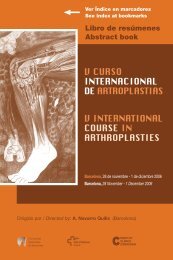Notas / Notes - Active Congress.......
Notas / Notes - Active Congress.......
Notas / Notes - Active Congress.......
You also want an ePaper? Increase the reach of your titles
YUMPU automatically turns print PDFs into web optimized ePapers that Google loves.
MARTES / TUESDAY<br />
18<br />
METAL-METAL COUPLE – SCIENTIFIC<br />
BASES<br />
Eric Robinson, Tajeshwar Singh Aulakh, Munir Khan,<br />
Jan-Herman Kuiper, James Richardson<br />
The Robert Jones & Agnes Hunt Orthopeadic Hospital.<br />
Oswestry Outcome Centre, Oswestry (Great Britain)<br />
Science is based on observation. Any hypothesis should<br />
then fit those observations and be open to testing. Metal on<br />
metal hip replacement was very successful with a design by<br />
Ring some 30 years ago. There were difficulties however<br />
with initial fixation to bone. I will show a case where a loose<br />
Ring stem was simply revised by re-cementing the original<br />
stem, and 8 years later the patient is functioning well! This<br />
observation helped to question the teaching I had received<br />
against metal-metal bearings.<br />
The metal on polythene hip has stood the test of time but<br />
John Charnley himself insisted it only be used for the older<br />
patient of 65 years or more. Some excellent long term results<br />
have been obtained in patients who had some other limiting<br />
factor from a young age that prevented them attaining a high<br />
mileage each year. We all know the problems of osteolysis<br />
related to the polythene debris from a metal on polythene<br />
joint. It is for these reasons that there is again a logical argument<br />
for using a metal on metal articulation in the younger<br />
and active patient.<br />
The Outcome Centre at Oswestry has been following 5000<br />
hip resurfacing (BHR) now out to 10 years. This is an independent<br />
review where information is gathered directly from patients.<br />
This has found a very high level of function and activity<br />
in patients with metal on metal resurfacing hip replacement.<br />
There is good survival out to 10 years with 95% survival. This<br />
group of patients is from a combined series of several surgeons<br />
across the world who were new to using this technique.<br />
Similarly, I have excellent results now out to 10 years with<br />
the Metasul articulation on a Thrust Plate. This is a short uncemented<br />
stem with strong initial stability and rigidity. These<br />
patients likewise have a high level of activity and the 8 year<br />
follow up was a 98% survival.<br />
What of the metal ions absorbed? Certainly in a minority of<br />
patients these have a hypersensitivity response which causes<br />
pain and cyst formation. All patients absorb some metal in<br />
the form of chromium and cobalt. These levels are highest in<br />
the joint and adjacent to the metal implants. Alterations in<br />
circulating cells have been noted and this causes concern.<br />
However, the observation of a local sarcoma adjacent to a<br />
metal implant is very rare indeed considering the numbers<br />
implanted worldwide and this includes a whole range of metal<br />
implants. The observation therefore is that in practice and<br />
indeed over many years it is unlikely that the risk of a local<br />
cancer is significant. Further observations and studies are<br />
needed to identify and quantify risks of leukaemia.<br />
The ‘bottom line’ is whether patients with hip resurfacing are<br />
dying at a faster rate than expected. Tajeshwar Aulakh has<br />
studied the mortality rates of the Oswestry 5,000 and finds<br />
the rate almost half as low as the expected.<br />
Munir Khan has studied the release and distribution of metal<br />
wear debris from metal on metal prostheses. Average size<br />
of the debris particles is 120 times smaller than a red blood<br />
cell. We found that this debris material is mostly concentrated<br />
in the extra-cellular portion of blood and that chromium has<br />
special affinity for plasma proteins. Therefore, measurements<br />
of plasma metal ion levels will provide more accurate results<br />
to compare release of wear debris in different hip prostheses.<br />
Moreover, our group was the first to show that metal ion levels<br />
increase following an hour of physiological exercise.<br />
The rise is of a few nanomoles that can only be picked if<br />
detection limits of the instrument are less than 1nmol/L. We<br />
found that determining the exercise-related cobalt rise is an<br />
accurate technique of determining in-vivo wear of metal on<br />
metal bearings, compared to resting plasma levels.<br />
We also studied the effects of metal ions on DNA. Using comet<br />
assay we found that cobalt and chromium ions caused<br />
DNA damage, which disappeared in the presence of apoptotic<br />
inhibitor. This apoptotic damage was misinterpreted as mutagenic<br />
in previous studies, but generally it is a safer thing for<br />
an agent to increase apoptosis.<br />
Our studies therefore echo the findings of epidemiologic studies<br />
in which researchers did not find a higher risk of cancer<br />
in patients with metal on metal bearing hip replacement at<br />
up to 30 years follow-up.<br />
METAL/METAL BEARING SURFACES:<br />
THE WAY OF THE FUTURE?<br />
Cecil H. Rorabeck, MD<br />
Health Sciencies Centre.<br />
London-Ontario (Canada)<br />
OBJECTIVE<br />
Polyethylene wear continues to be the most significant issue<br />
following total hip arthroplasty (THA) leading to the current<br />
increase in use of alternative bearing surfaces. We performed<br />
a prospective, randomized, blinded clinical trial comparing<br />
metal versus polyethylene bearing surfaces in patients receiving<br />
THA.





